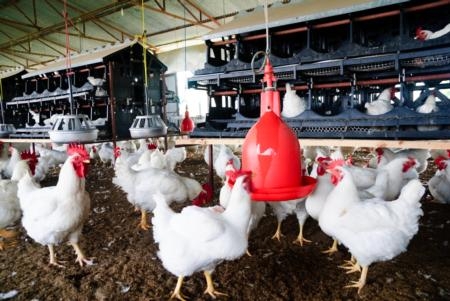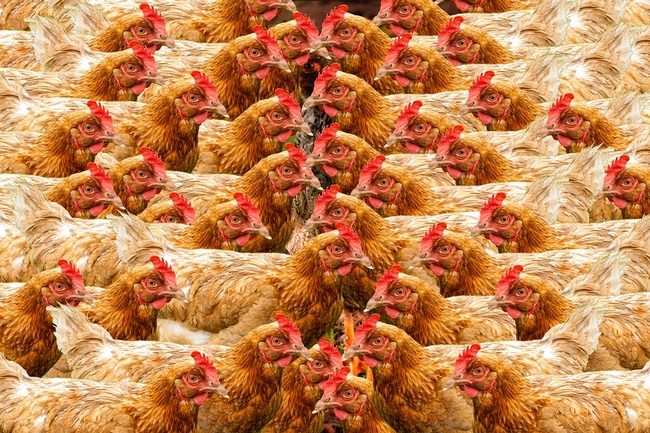
Posts Tagged: Proposition 1
Prop 12 builds on food animal welfare initiative passed 10 years ago
Proposition 12, a measure on California's Nov. 6 ballot, builds on the successful ballot measure Prop. 2, which 10 years ago required veal calves, breeding pigs and egg-laying hens to be kept on farms that allowed them to turn around freely, lie down, stand up and extend their limbs, reported Paul Rogers in the Mercury News.
However, CDFA issued guidelines that said chickens could still be kept in cages and be in compliance with the law. That prompted sponsors - including the Humane Society, the American Society for the Prevention of Cruelty to Animals and other groups - to propose Prop 12, which will tighten the law. If passed by a simple majority, the new proposition would require 43 square feet of space for each calf raised for veal by 2020, 24 square feet for each breeding pig by 2022 and one square foot per hen by 2020, with all egg-laying hens required to be cage-free by 2022 — in other words, allowed to roam around a barn or large coop. Farmers from other states would also have to comply with these dimensions to sell their products in California.
Since Prop 2 went into effect, egg prices increased by 9 percent. California is also producing fewer eggs. In 2007, 5.3 billion eggs were laid by California chickens, with a value of $346 million. By 2015, California chickens laid 3.5 billion eggs with a value of $210 million.
Some of the decline would have happened anyway, said economist Daniel Sumner, director of UC Agriculture and Natural Resources' Agricultural Issue Center.
“The egg industry has been declining for decades in California,” Sumner said. “Raising eggs is about converting corn and soybeans to eggs. It's expensive to haul corn and soybeans around. And we don't grow corn and soybeans in California.”
But Sumner predicted if Prop 12 passes, it will raise the price of some types of eggs, perhaps by as much as 50 percent, and the price of veal and pork by about 20 percent.
“People spend 50 to 100 dollars a year on eggs,” Sumner told reporter Lesley McClurg of KQED. “It'll go up to $100 to $150.”
Though another factor could also be at play in egg prices: an uncertain future.
“The concern for the people investing in these new standards is that it's not at all clear that they're going to last very long,” says Sumner.
$7.12 billion state water bond to appear on November ballot

Per the full text of the proposition, the distribution of funds would be approximately as follows:
$810 million for expenditures and competitive grants and loans to integrated regional water management plan projects.
$520 million to improve water quality for “beneficial use,” for reducing and preventing drinking water contaminants in disadvantaged communities, and creating the State Water Pollution Control Revolving Fund Small Community Grant Fund.
$725 million for water recycling and advanced water treatment technology projects.
$900 million for competitive grants, and loans for projects to prevent or clean up the contamination of groundwater that serves as a source of drinking water.
$1.495 billion for competitive grants for multi-benefit ecosystem and watershed protection and restoration projects including:
- Conservancies $327.5M.
- Wildlife Conservation Board $200M (restoration of flows)
- Department of Fish and Wildlife $285M (out of delta, no mitigation on Bay Delta Conservation Plan)
- Department of Fish and Wildlife $87.5M (in delta with constraints)
- State settlement obligations including CVPIA $475M
- Rivers and creeks $120M
$2.7 billion for water storage projects, dams and reservoirs.
$395 million for statewide flood management projects and activities
To read the full text of the proposition visit Ballotpedia.
GMO labeling is costly proposition for California
Proposition 37 would result in $1.2 billion in higher costs for farmers and food processors, higher prices for consumers and new regulations, according to an article published in Western Farm Press that refers to a new UC Davis study. The article is credited to the No on 37 campaign.
If passed, Proposition 37, which is on California's November ballot, would require labeling of genetically engineered food.
“The proposed regulations have no basis in science and impose rules that would have significant costs for food producers, processors and marketers, and ultimately for consumers, while providing misinformation and no demonstrable benefits,” the article quotes Julian Alston and Daniel Sumner, professors in the Department of Agricultural and Resource Economics at UC Davis.
An editorial in the Los Angeles Times notes that the work for the study was undertaken with partial funding support from No on 37.
"That doesn't mean the study is without interest for voters," wrote Karin Klein in the editorial.
Dan Sumner a part of NY Times animal cruelty debate
New laws were proposed this spring in Iowa, Minnesota and Florida that would make it a crime to take undercover videos or photos at industrial farms, a tactic often used to show mistreatment of animals and unsanitary conditions, the New York Times reported.
In response to this development, the Times invited nine experts to debate issues related to farm animal welfare. The director of the UC Agricultural Issues Center, Dan Sumner, took part in the discussion, noting that in addition to legal and moral questions, there are economic issues worth considering.
In his essay, titled Economics in the Hen House, Sumner outlined Proposition 2, a law voters approved in 2008 that ends the use of conventional cages in California egg production by 2015. Sumner said the new law will ban eggs that 95 percent of buyers now choose - less expensive, conventionally produced eggs - and allow only more expensive "free range chicken" eggs, which are already available, but rejected by the vast majority of shoppers.
He believes the use of graphic images in the campaign detracted from an informed policy debate about the potential impacts of Proposition 2. Emotional appeals with ugly images can sway a public debate, he said, while noting that farmers also use their own favored images to garner support for farm policy.
"A picture may be worth a thousand words, but sometimes a few numbers and some evidence may be worth even more," Sumner concluded.

Hen house living conditions are part of the animal welfare debate.
Media outlet takes notice of new ANR council
The University of California issued a news release about a new Animal Welfare Council on May 19. Jim Downing of the Sacramento Bee picked it up, writing in a story published today that "The University of California, hoping to insert itself as a peacemaker, formed a new animal welfare council last month."
Downing's article focused on voters' overwhelming support of Proposition 2 last November, which, among other things, requires farmers to give egg-laying chickens room to spread their wings. However, the story says the battle over hen housing has "only just begun."
The story mentions that:
- The university is being sued by the Humane Society over what the group says was an industry-biased analysis of Proposition 2 during the campaign.
- The Human Society is backing Assembly Bill 1437, which would require all eggs sold in the state - not just those produced in the state - be laid by cage-free hens.
- Farmers are looking at various options for complying with Prop 2, such as a 60-hen "colony" cages used on some farms in Europe.

